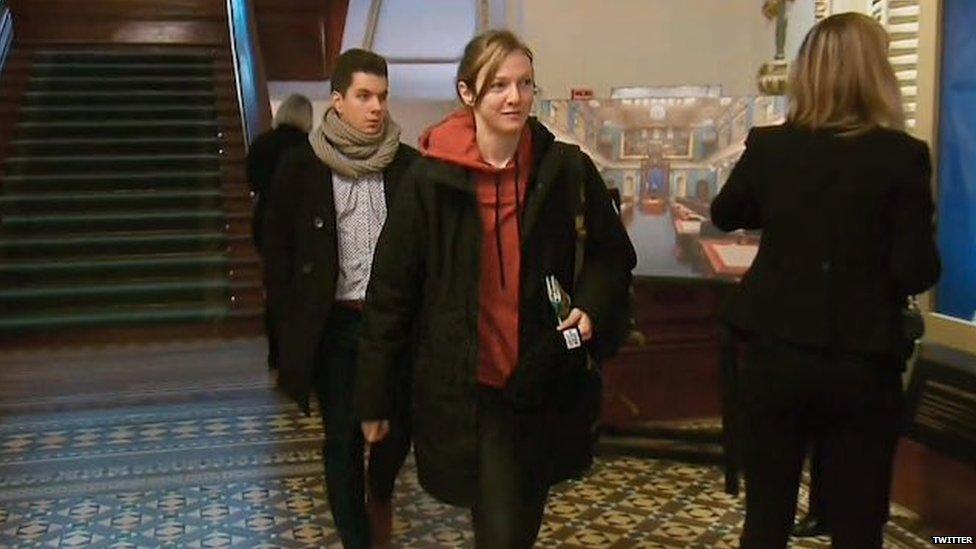Hoodie gets Quebec politician thrown out of legislature
- Published

From bare arms in the US House of Representatives to ties in the UK's House of Commons, what politicians wear to work can say a lot about the traditions they hold dear - and the ones they want to leave behind.
Mark Zuckerberg made hoodies de rigueur in Silicon Valley.
But can they catch on in the halls of Quebec's legislature?
Quebec politician Catherine Dorion, who is a member of the left-wing Quebec Solidaire party, pushed the fashion envelope when she entered the provincial legislature wearing jeans and a hoodie sweatshirt last week.
After several colleagues complained, Ms Dorion, who represents the district of Taschereau, decided to leave, because she "didn't want to cause a scene", said a spokesperson for her party.
Allow X content?
This article contains content provided by X. We ask for your permission before anything is loaded, as they may be using cookies and other technologies. You may want to read X’s cookie policy, external and privacy policy, external before accepting. To view this content choose ‘accept and continue’.
Her sartorial stand has sparked a debate over appropriate attire for politicians, along with a hashtag, #moncotonouatémonchoix (which translates to my hoodie, my choice).
What is the Quebec government's dress code?
The National Assembly, Quebec's provincial legislature, has no official dress code, only the guidance that members' attire should "contribute to the maintenance of decorum".
It is customary that during parliamentary proceedings, men wear a jacket and tie, and women a dress suit. Public servants are also banned from wearing religious symbols.
But last February speaker François Paradis was forced to address the issue after there were complaints about several members, mostly from Quebec Solidaire, wearing trainers, jeans and Doc Martens. He said the assembly should debate the issue, and come up with formal guidelines.
"Certainly, I do not think that it will be up to me, as president, to decide unilaterally. This is an issue which, following exchanges that we may have if necessary, will have to be decided collectively. I would strongly hope that a broad consensus emerges as is the case when we consider the possibility of reviewing our rules of procedure," he said.
He urged members to wear "city dress" or business casual, until an official dress code could be decided on.
What does Ms Dorion say?
Speaking on television programme Tout le Monde en Parle, Ms Dorian said she wears casual clothes to the assembly because she represents real people, not just the political class.
"The National Assembly is the house of the people, it is you, the world, who should be there, not all the same clique," she said.
This was not the first time her outfits have been considered a faux pas.
This Halloween, a few days before hoodiegate, Ms Dorion posted a photo on social media of herself wearing a skirt-suit and sitting on top of a desk in the National Assembly, the joke being that she was "in costume" as an old-fashioned politician.
In response, the Liberal Party filed a letter of complaint with the ethics commissioner, saying her Halloween costume was disrespectful.
She said she was "shocked and disappointed" the party would lecture her.
What has the reaction been?
Many people have spoken in support of Ms Dorion, arguing that men are not scrutinised as closely for what they wear, and that the assembly should modernise.
Some supporters even created a campaign to get women to wear a hoodie to work on Tuesday in solidarity, external.
"Women's bodies do not belong to you. Women's clothing choice does not belong to you," says the campaign's Facebook group.
Allow X content?
This article contains content provided by X. We ask for your permission before anything is loaded, as they may be using cookies and other technologies. You may want to read X’s cookie policy, external and privacy policy, external before accepting. To view this content choose ‘accept and continue’.
But others say sexism has nothing to do with it, and that a sweatshirt is just not acceptable office attire.
"A little common sense please! I'm open-minded but we still have to respect certain standards in life, even if we're ultra open," wrote one person on the Facebook group created to support Ms Dorion.
Is this an issue anywhere else?
In the age of business casual and office jeans, what counts as professional attire isn't always clear - even for politicians.
Most of the debate has centred around women's attire, and whether bare arms are appropriate.
Michelle Rempel refused to withdraw the "F" word
In the US, Congress bans sleeveless tops, trainers and open-toed shoes, but the rules are not always enforced. In 2017, several congresswomen protested by organising a "sleeveless Friday".
In Canada, the province of British Columbia has proposed to amend its dress code to allow for sleeveless tops.
Men sometimes run afoul of dress codes too. In Montreal, a city councillor was kicked out of a meeting for not wearing a tie. Those rules were changed in 2018.
Outgoing UK Speaker of the House John Bercow ruffled a few feathers when he said MPs did not need to wear ties. He also made waves personally when he abandoned the speaker's traditional waistcoat, cuffs and winged collar, opting instead for a more modern suit under his robe.
- Published17 June 2019

- Published7 April 2017
